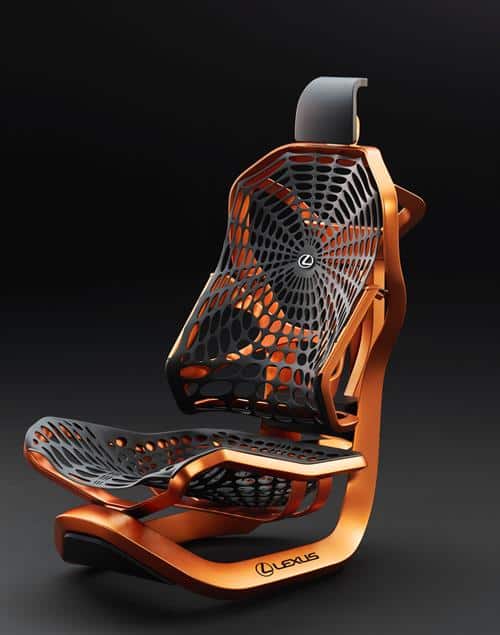 Lexus announced it will debut the Kinetic Seat Concept at the 2016 Paris Motor Show. The upholstery is made form synthetic protein-based faux genetically engineered spider silk in a web pattern. It looks cools and should feel cool. It’s looks like an Aeron chair decorated for Halloween.
Lexus announced it will debut the Kinetic Seat Concept at the 2016 Paris Motor Show. The upholstery is made form synthetic protein-based faux genetically engineered spider silk in a web pattern. It looks cools and should feel cool. It’s looks like an Aeron chair decorated for Halloween.
In humans, the spine acts to stabilize the head. It allows the pelvis and chest to rotate in opposite directions, stabilizing movement of the head even while walking or jogging. In order to recreate this movement in car seats, the seat cushion and back rest were designed to move kinetically with occupant weight and external forces. Thus, simply sitting in the seat helps stabilize head movement caused by vehicle motion, keeping the field of vision steady. This reduces the burden on occupants, improving ease of driving and comfort.
The seat frame “upholstery” comprises a spider web-pattern net with threads that spread out radially from the center of the back rest. The net is sufficiently flexible to closely fit body shape, dispersing the load to help make it possible to sit comfortably for prolonged periods. The center of the back rest is at shoulder blade height, which induces rotational movement of the chest around the seat’s pivotal axis. This helps to stabilize the head and thus helps to ensure a high level of support. The seat has also been made slimmer, making the overall car lighter in weight.
The threads at the back rest of the spider web-pattern construction are made from environmentally-conscious synthetic spider silk materials* instead of petroleum-derived materials. The main component of this material is protein, which is created through microbial fermentation, then spun and processed into a new material offering superior shock absorbance properties. The greatest property of spider silk is its incredible toughness. This material has the equivalent strength of carbon fiber, but an amazing 40 times the toughness. The seat is covered with QMONOS material developed by Spiber Inc.
The artificial spider silk produced at Spiber is optimized through four processes. First, the silk-producing regions of the spider’s genome are analyzed. Spiber then artificially synthesize a gene to maximize strength, elasticity, and the potential for industrial productivity using genetic engineering techniques. Second, Spiber introduce this recombinant gene into a microbe and culture it. They then separate the spider silk protein from the host microbes. Third, the resulting protein is refined and spun into a fiber. Finally, this fiber is then used in the development of a variety of products and the resulting properties are examined. The results of these examinations, including productivity and fiber properties, are stored in a database, and this hypothesis-driven trial and error knowledge is used in the next series of development. In this way, each iteration of the material becomes more and more refined as each generation of research progresses.